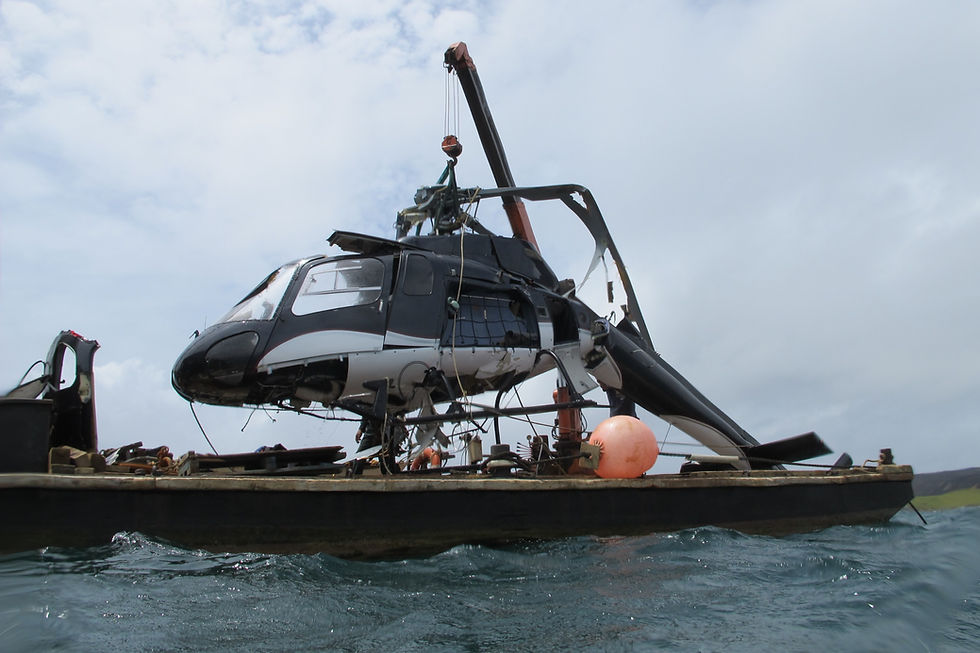What Are the Different Types of Marine Salvage?
- Jason Harwood

- Jul 25
- 3 min read
Marine salvage goes far beyond lifting sunken ships off the ocean floor. It covers a wide range of recovery operations, each with its own risks, goals, and technical requirements. At Harcan Marine, we handle all types of marine salvage with the same focus: safety, precision, and reliable outcomes.
If you’re wondering what exactly goes into a salvage job, this guide explains the types of marine salvage and what sets each one apart.

What is a Common Salvage Operation?
So, what is a common salvage operation? That depends on where and how the vessel or object is located. Some jobs require rapid emergency response near the coast, while others involve long-term wreck removal or deep-sea recovery. Breaking salvage into categories makes it easier to plan and execute the work safely and effectively.
Not all salvage jobs are created equal. Factors like the vessel's condition, location of the incident, environmental risks, and urgency all affect how a recovery should be handled. That’s why salvage work is generally broken down into a few key categories.
Each type of salvage requires specific equipment, dive procedures, and team expertise. That’s where Harcan Marine’s diverse experience and access to marine plant hire give us an edge.
1. Offshore Salvage
This involves vessels or equipment lost far from shore, typically in deep water. Operations may involve strong currents, poor visibility, or unpredictable weather.
Offshore salvage requires:
Specialised vessels: like dive support ships or barges.
Heavy-duty lifting gear: including cranes, pontoons, or flotation bags.
Highly skilled divers: certified and experienced in remote, high-risk environments.
Offshore jobs often involve coordination with maritime authorities and can take several days or weeks to complete.
2. Harbour or Coastal Salvage
Closer to shore but still challenging, this type of salvage focuses on ports, rivers, or nearshore environments. These jobs are often urgent, especially if a sunken vessel is blocking a channel or damaging infrastructure.
Coastal salvage usually involves:
Rapid deployment: often under tight timeframes to avoid economic disruption.
Environmental care: fuel or cargo leaks must be managed quickly.
Diving and lifting equipment: suited for shallower water, but still robust.
Harcan Marine’s fleet and team are perfectly positioned for this work across Queensland, New South Wales, and Victoria.
3. Wreck Removal
Wreck removal is often a large-scale operation that focuses on permanently clearing the seafloor of sunken or derelict vessels. Unlike emergency salvage, these are often planned and permitted in advance.
This type of marine salvage includes:
Cutting and sectioning: to remove large wrecks in pieces.
Debris containment: to prevent environmental harm.
Full-site remediation: ensuring the area is left clean and safe.
Wreck removals are common in ports, shipping lanes, and areas undergoing redevelopment.
4. Cargo Salvage
Sometimes the vessel isn’t the only thing worth recovering. Cargo salvage focuses on retrieving valuable goods from a sunken or grounded ship. Sometimes, cargo is recovered even if the vessel is beyond saving.
This may involve:
Secure packaging and lift bags: for fragile or hazardous materials.
ROV assistance: when divers can't safely access the site.
Detailed inventory and reporting: often required by insurers.
Harcan’s team approaches cargo recovery carefully, keeping safety and value preservation at the forefront.
5. Environmental or Hazardous Salvage
These jobs require fast action. The goal is to remove a wreck or debris that’s posing an environmental or public safety risk. This may include chemical leaks, submerged machinery, or waste.
Key steps in this type of salvage include:
Hazard containment: such as booms or barriers.
Confined space and contaminated water protocols: followed to the letter.
Safe disposal or decontamination: handled with expert care.
Our teams are fully certified for confined space, hazardous material handling, and high-risk diving.
How to Choose the Right Marine Salvage Team
Not all salvage crews are created equal. When choosing a team, look for experience in complex underwater environments, access to specialised equipment, and a proven track record in safe, efficient recoveries.
Things worth checking:
Do they offer custom salvage planning for different asset types?
Are their divers certified and familiar with local conditions?
Can they provide rapid mobilisation when time is tight?
Do they have access to the right gear, like barges, pontoons, and subsea equipment?
Let’s Talk About Your Salvage Project
If you're facing a wreck, blocked channel, or submerged equipment, you need a team that can act fast with the right tools and knowledge.
Harcan Marine handles all types of marine salvage, from routine jobs to complex recoveries and commercial diving services. Contact us today to discuss your next project and how we can help bring your operations back online quickly and safely.





Comentários